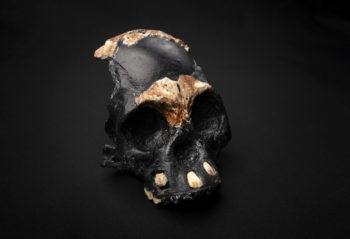Partial Skull Discovery Raises New Questions About Human Origins

An international team of researchers that includes a Texas A&M University anthropologist has revealed the partial skull of a young child who is believed to have died at least 250,000 years ago in a cave near Johannesburg, South Africa. The find raises critical new questions about the origins of the human species.
Darryl de Ruiter, professor and head of anthropology at Texas A&M, along with 21 colleagues from 13 other universities, details the discovery in PaleoAnthropology, a leading journal of anthropology.
The project shows the area and circumstances in which the skull – of a type of human ancestor called Homo naledi – was discovered. The team uncovered parts of the skull and teeth of the child who died when they were approximately 4 to 6 years old.
de Ruiter said almost 2,000 skeleton fragments of more than two dozen individuals at all life stages of Homo naledi have been recovered since the Rising Star cave system was discovered in 2013, making it the richest site for fossil hominins ever found in Africa. But this skull discovery is special because in earlier studies, the youngest individuals were identified only by their teeth and lower jaws.
“There were no replicating parts as we pieced the skull back together and many of the fragments refit, indicating they all came from one individual child,” said de Ruiter, who previously led a study of the adult skull of Homo naledi.
The skull of the child was recovered during further work in the cramped spaces of the cave in 2017. It was found alone, and no remains of its body have been recovered, de Ruiter said. The team has named the child “Leti,” which means “the lost one” in the nearby Setswana tribal language.
de Ruiter said that Leti’s skull consists of 28 skull fragments and six teeth. The discovery of a hominin (extinct human relative) child skull is an extremely rare find in the fossil record because juvenile remains tend to be thin and extremely fragile, de Ruiter said.
The find sheds new light on a primitive species that existed at a time when it was thought only modern humans were in Africa, and it helps to understand a time frame concerning the invention of complex stone tool cultures and even ritual practices, said Lee Berger, project leader and director of the Centre for Exploration of the Deep Human Journey at Wits University and an explorer-at- large for the National Geographic Society.
“Homo naledi remains one of the most enigmatic ancient human relatives ever discovered,” Berger said.
Leti’s brain size is estimated at around 480 to 610 cubic centimeters (about the size of a grapefruit) and would have been almost 95 percent of its adult brain capacity.
“This is the first partial skull of a child of Homo naledi yet recovered and this begins to give us insight into all stages of life of this remarkable species,” said Juliet Brophy, a professor from LSU who received her doctorate from Texas A&M. Brophy led the study on Leti’s skull and teeth condition.
de Ruiter said it is still not known how old Leti’s remains are, but the team believes they likely date to around 250,000 years ago based on other fossils of Homo naledi found in the nearby Dinaledi Chamber.
With no signs of damage from carnivores or scavenging, and no evidence of the skull having been washed into the narrow cave passage, the team does not know how Leti’s skull came to rest in such a remote and inaccessible part of the system, Brophy said. The researchers believe that it is likely other members of the species were somehow involved in the skull reaching such a difficult place.
Leti’s remains were discovered in a tight passage that is only a few inches wide.
The Rising Star cave system has become one of the most prolific sites of discovery for hominin fossils in the world. de Ruiter said that work is continuing throughout the cave system, and the team believes that new discoveries are likely to shed further light on whether these chambers and passages are in fact a burial ground of Homo naledi remains.
“The discovery of a single skull of a child, in such a remote location within the cave system, adds mystery as to how these many remains came to be in these remote, dark spaces of the Rising Star cave system,” Berger said. “It is just another riddle among many that surround this fascinating extinct human relative.”
Media contacts:
- Darryl de Ruiter, 979-458-4037, deruiter@tamu.edu
- Juliet Brophy, 847-846-3325, jbrophy@lsu.edu
- Lee Berger (+27) 83-454-6309, berger@wits.ac.za





